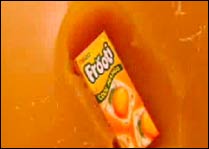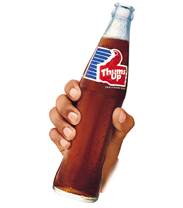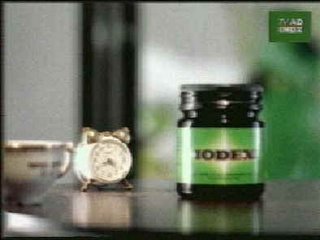Brand : Frooti
Company: Parle Agro foods
Agency: Grey worldwide
Frooti is the first tetrapak fruit juice in India. Launched in 1984, Frooti still holds a dominant position in the Rs300 crore tetrapak fruit juice (TFJ) market.
Frooti over these years have carved out a niche for itself in the market. Frooti instantly caught the fancy of Indian consumer with its tetrapak and some smart campaigns. Initially the drink was positioned as a kids drink. The product was perceived as a healthy fruit drink by the mothers . So within a short span of time ,the brand was an alternative to the “unhealthy” colas. The tetrapak had other benefits also . Fruit juice is a perishable product and tetrapak have extended the shelf life of Frooti because tetrapaks have 2 layers of paper and a plastic coating that ensured tamper proof and enhanced shelf life.
Lured by the success of Frooti, there was a lot of new launches in the TFJ market. Players like Godrej with Jumpin, kissan etc tried their luck in this market but failed to dislodge Frooti.
Froo ti was positioned as a mango drink that is “Fresh-n-juicy” For over a 7 years, the company promoted the product using that famous baseline. The product have tried to create excitement in the market through a series of new variants and packing. But in late ninetees the brand was facing stagnated sales. The company tried to excite the market with an orange and pineapple variant but both the variant bombed. The came the experiment with packaging . The YO! Frooti variant came with a slim paper can aimed at the college going youth.
ti was positioned as a mango drink that is “Fresh-n-juicy” For over a 7 years, the company promoted the product using that famous baseline. The product have tried to create excitement in the market through a series of new variants and packing. But in late ninetees the brand was facing stagnated sales. The company tried to excite the market with an orange and pineapple variant but both the variant bombed. The came the experiment with packaging . The YO! Frooti variant came with a slim paper can aimed at the college going youth.
Worried by the stagnating sales, Parle tried to reposition the brand to appeal to youth aged between 16-21. The positioning changed to be more fun based. The package also changed. The old green color of the bottle changed to more bright mango color with lot of graphics added to it.
One of the most famous marketing campaigns India have witnessed took place during the repositioning. The campaign is the famous “ Digen Verma “ campaign. This campaign was considered as one of the most successful teaser campaigns in India. The campaign lasted for 15 days started in February 2001. The campaign was about a faceless person Digen Verma. There were p osters and outdoors all across the markets that had messages like “ Who is Digen verma” “ Digen Verma was here” etc. This created lot of excitement in the market and “Digen Verma “became the most talked about faceless name at that time. The campaign was executed by Everest communication. But the campaign was not followed up and the hype was not translated to long term brand building.
osters and outdoors all across the markets that had messages like “ Who is Digen verma” “ Digen Verma was here” etc. This created lot of excitement in the market and “Digen Verma “became the most talked about faceless name at that time. The campaign was executed by Everest communication. But the campaign was not followed up and the hype was not translated to long term brand building.
Frooti is basically a nectar based drink so it is not 100% fruit juice, it also have some preservatives added to increase the shelf life. Although Frooti did not face much competition in the category it created, competition came from a slightly different category, 100% fruit juices. Parle saw the emergence of the “ 100% fruit drink market and launched “Njoy” brand but it did not clicked. Parle could have extended Frooti to this market also .The brand Real from Dabur is the main player in this category. Real effectively positioned itself as a premium healthy drink for adults. Frooti was not able to appeal to adults and was considered as a mango drink while Real is not restricted to any flavour. Frooti also changed its positioning statement from ‘ Fresh-N-juicy” to “ Juice Up your life” which have not clicked with the customers.
Although Frooti enjoys a commanding (75%) market share , Frooti is facing stagnation. May be some serious steps should be taken to increase the usage of the product. The launch of PET bottle Frooti is a step in this direction. Recently Frooti also launched a “Green mango” variant just to create some hype in the market. Frooti may have to reposition itself again to appeal to cola drinkers.
Company: Parle Agro foods
Agency: Grey worldwide
Frooti is the first tetrapak fruit juice in India. Launched in 1984, Frooti still holds a dominant position in the Rs300 crore tetrapak fruit juice (TFJ) market.

Frooti over these years have carved out a niche for itself in the market. Frooti instantly caught the fancy of Indian consumer with its tetrapak and some smart campaigns. Initially the drink was positioned as a kids drink. The product was perceived as a healthy fruit drink by the mothers . So within a short span of time ,the brand was an alternative to the “unhealthy” colas. The tetrapak had other benefits also . Fruit juice is a perishable product and tetrapak have extended the shelf life of Frooti because tetrapaks have 2 layers of paper and a plastic coating that ensured tamper proof and enhanced shelf life.
Lured by the success of Frooti, there was a lot of new launches in the TFJ market. Players like Godrej with Jumpin, kissan etc tried their luck in this market but failed to dislodge Frooti.
Froo
 ti was positioned as a mango drink that is “Fresh-n-juicy” For over a 7 years, the company promoted the product using that famous baseline. The product have tried to create excitement in the market through a series of new variants and packing. But in late ninetees the brand was facing stagnated sales. The company tried to excite the market with an orange and pineapple variant but both the variant bombed. The came the experiment with packaging . The YO! Frooti variant came with a slim paper can aimed at the college going youth.
ti was positioned as a mango drink that is “Fresh-n-juicy” For over a 7 years, the company promoted the product using that famous baseline. The product have tried to create excitement in the market through a series of new variants and packing. But in late ninetees the brand was facing stagnated sales. The company tried to excite the market with an orange and pineapple variant but both the variant bombed. The came the experiment with packaging . The YO! Frooti variant came with a slim paper can aimed at the college going youth.Worried by the stagnating sales, Parle tried to reposition the brand to appeal to youth aged between 16-21. The positioning changed to be more fun based. The package also changed. The old green color of the bottle changed to more bright mango color with lot of graphics added to it.
One of the most famous marketing campaigns India have witnessed took place during the repositioning. The campaign is the famous “ Digen Verma “ campaign. This campaign was considered as one of the most successful teaser campaigns in India. The campaign lasted for 15 days started in February 2001. The campaign was about a faceless person Digen Verma. There were p
 osters and outdoors all across the markets that had messages like “ Who is Digen verma” “ Digen Verma was here” etc. This created lot of excitement in the market and “Digen Verma “became the most talked about faceless name at that time. The campaign was executed by Everest communication. But the campaign was not followed up and the hype was not translated to long term brand building.
osters and outdoors all across the markets that had messages like “ Who is Digen verma” “ Digen Verma was here” etc. This created lot of excitement in the market and “Digen Verma “became the most talked about faceless name at that time. The campaign was executed by Everest communication. But the campaign was not followed up and the hype was not translated to long term brand building.Frooti is basically a nectar based drink so it is not 100% fruit juice, it also have some preservatives added to increase the shelf life. Although Frooti did not face much competition in the category it created, competition came from a slightly different category, 100% fruit juices. Parle saw the emergence of the “ 100% fruit drink market and launched “Njoy” brand but it did not clicked. Parle could have extended Frooti to this market also .The brand Real from Dabur is the main player in this category. Real effectively positioned itself as a premium healthy drink for adults. Frooti was not able to appeal to adults and was considered as a mango drink while Real is not restricted to any flavour. Frooti also changed its positioning statement from ‘ Fresh-N-juicy” to “ Juice Up your life” which have not clicked with the customers.
Although Frooti enjoys a commanding (75%) market share , Frooti is facing stagnation. May be some serious steps should be taken to increase the usage of the product. The launch of PET bottle Frooti is a step in this direction. Recently Frooti also launched a “Green mango” variant just to create some hype in the market. Frooti may have to reposition itself again to appeal to cola drinkers.







